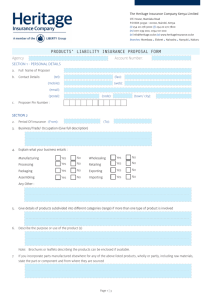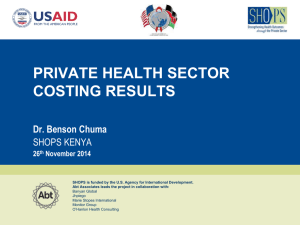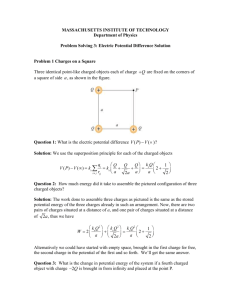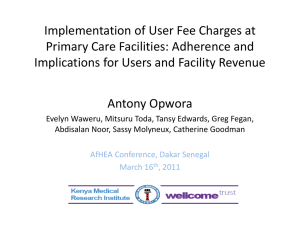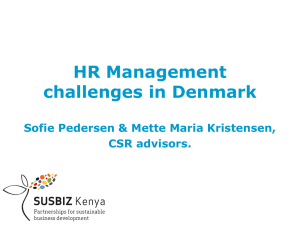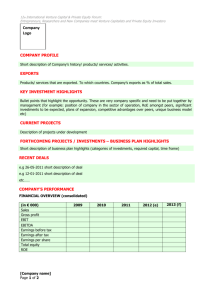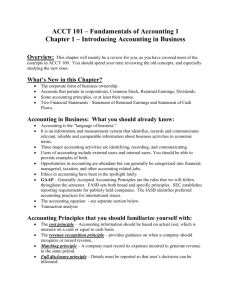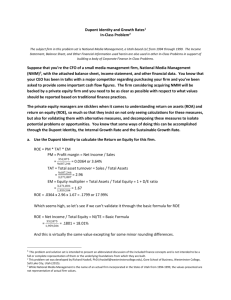RWJ 7th Edition Solutions
advertisement
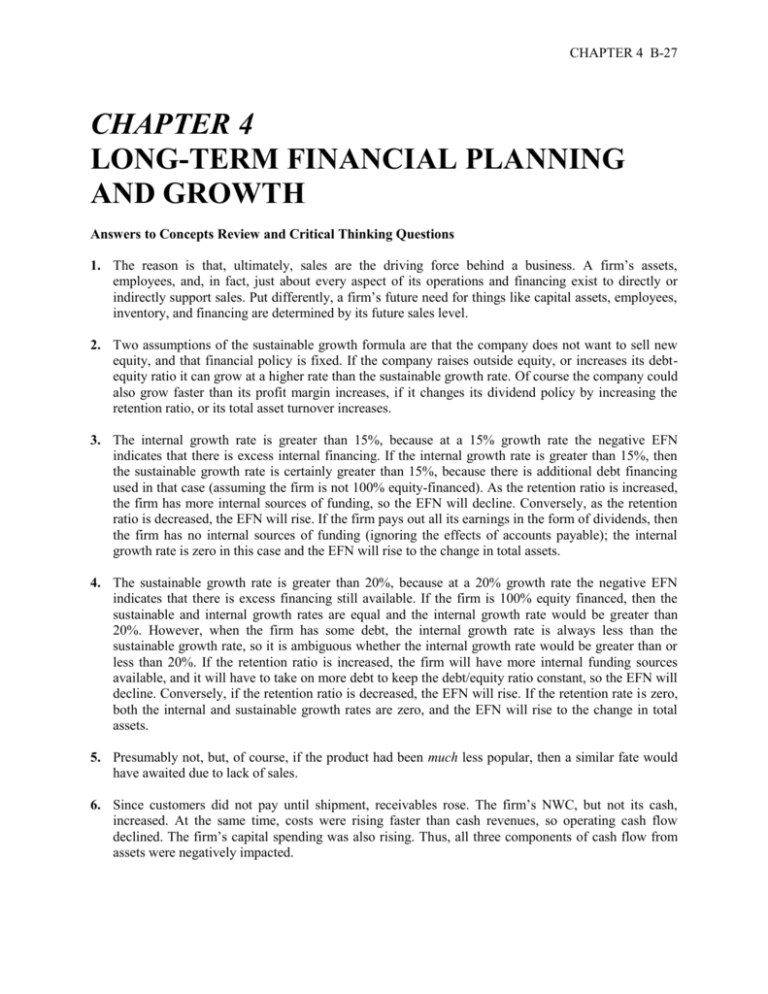
CHAPTER 4 B-27
CHAPTER 4
LONG-TERM FINANCIAL PLANNING
AND GROWTH
Answers to Concepts Review and Critical Thinking Questions
1. The reason is that, ultimately, sales are the driving force behind a business. A firm’s assets,
employees, and, in fact, just about every aspect of its operations and financing exist to directly or
indirectly support sales. Put differently, a firm’s future need for things like capital assets, employees,
inventory, and financing are determined by its future sales level.
2. Two assumptions of the sustainable growth formula are that the company does not want to sell new
equity, and that financial policy is fixed. If the company raises outside equity, or increases its debtequity ratio it can grow at a higher rate than the sustainable growth rate. Of course the company could
also grow faster than its profit margin increases, if it changes its dividend policy by increasing the
retention ratio, or its total asset turnover increases.
3. The internal growth rate is greater than 15%, because at a 15% growth rate the negative EFN
indicates that there is excess internal financing. If the internal growth rate is greater than 15%, then
the sustainable growth rate is certainly greater than 15%, because there is additional debt financing
used in that case (assuming the firm is not 100% equity-financed). As the retention ratio is increased,
the firm has more internal sources of funding, so the EFN will decline. Conversely, as the retention
ratio is decreased, the EFN will rise. If the firm pays out all its earnings in the form of dividends, then
the firm has no internal sources of funding (ignoring the effects of accounts payable); the internal
growth rate is zero in this case and the EFN will rise to the change in total assets.
4. The sustainable growth rate is greater than 20%, because at a 20% growth rate the negative EFN
indicates that there is excess financing still available. If the firm is 100% equity financed, then the
sustainable and internal growth rates are equal and the internal growth rate would be greater than
20%. However, when the firm has some debt, the internal growth rate is always less than the
sustainable growth rate, so it is ambiguous whether the internal growth rate would be greater than or
less than 20%. If the retention ratio is increased, the firm will have more internal funding sources
available, and it will have to take on more debt to keep the debt/equity ratio constant, so the EFN will
decline. Conversely, if the retention ratio is decreased, the EFN will rise. If the retention rate is zero,
both the internal and sustainable growth rates are zero, and the EFN will rise to the change in total
assets.
5. Presumably not, but, of course, if the product had been much less popular, then a similar fate would
have awaited due to lack of sales.
6. Since customers did not pay until shipment, receivables rose. The firm’s NWC, but not its cash,
increased. At the same time, costs were rising faster than cash revenues, so operating cash flow
declined. The firm’s capital spending was also rising. Thus, all three components of cash flow from
assets were negatively impacted.
B-28 SOLUTIONS
7. Apparently not! In hindsight, the firm may have underestimated costs and also underestimated the
extra demand from the lower price.
8. Financing possibly could have been arranged if the company had taken quick enough action.
Sometimes it becomes apparent that help is needed only when it is too late, again emphasizing the
need for planning.
9. All three were important, but the lack of cash or, more generally, financial resources ultimately
spelled doom. An inadequate cash resource is usually cited as the most common cause of small
business failure.
10. Demanding cash up front, increasing prices, subcontracting production, and improving financial
resources via new owners or new sources of credit are some of the options. When orders exceed
capacity, price increases may be especially beneficial.
Solutions to Questions and Problems
NOTE: All end of chapter problems were solved using a spreadsheet. Many problems require multiple
steps. Due to space and readability constraints, when these intermediate steps are included in this
solutions manual, rounding may appear to have occurred. However, the final answer for each problem is
found without rounding during any step in the problem.
Basic
1.
It is important to remember that equity will not increase by the same percentage as the other assets.
If every other item on the income statement and balance sheet increases by 10 percent, the pro forma
income statement and balance sheet will look like this:
Pro forma income statement
Sales
Costs
NI
NZD 17,600
13,750
NZD 3,850
Pro forma balance sheet
Assets
Total
NZD 9,790
_________
NZD 9,790
In order for the balance sheet to balance, equity must be:
Equity = Total liabilities and equity – Debt
Equity = NZD 9,790 – 5,610
Equity = NZD 4,180
Equity increased by:
Equity increase = NZD 4,180 – 3,800
Equity increase = NZD 380
Debt
Equity
Total
NZD 5,610
4,180
NZD 9,790
CHAPTER 4 B-29
Net income is NZD 3,850 but equity only increased by NZD 380; therefore, a dividend of:
Dividend = NZD 3,850 – 380
Dividend = NZD 3,470
must have been paid. Dividends paid is the plug variable.
2.
Here we are given the dividend amount, so dividends paid is not a plug variable. If the company pays
out one-half of its net income as dividends, the pro forma income statement and balance sheet will
look like this:
Pro forma income statement
Sales
Costs
Net income
NZD 17,600
13,750
NZD 3,850
Pro forma balance sheet
Assets
NZD 9,790
_________
NZD 9,790
Total
Debt
Equity
Total
NZD 5,100
5,725
NZD 10,825
Dividends NZD 1,925
Add. to RE
1,925
Note that the balance sheet does not balance. This is due to EFN. The EFN for this company is:
EFN = Total assets – Total liabilities and equity
EFN = NZD 9,790 – 10,825
EFN = –NZD 1,035
3. An increase of sales to PEN 23,040 is an increase of:
Sales increase = (PEN 23,040 – 19,200) / PEN 19,200
Sales increase = .20 or 20%
Assuming costs and assets increase proportionally, the pro forma financial statements will look like
this:
Pro forma income statement
Sales PEN 23,040.00
Costs
18,660.00
EBIT
4,380.00
Taxes(34%) 1,489.20
NI
PEN 2,890.80
Pro forma balance sheet
Assets PEN 111,600
Total
PEN 111,600
Debt
Equity
Total
PEN 20,400.00
74,334.48
PEN 94,734.48
The payout ratio is constant, so the dividends paid this year is the payout ratio from last year times
net income, or:
Dividends = (PEN 963.60 / PEN 2,409)(PEN 2,890.80)
Dividends = PEN 1,156.32
The addition to retained earnings is:
Addition to retained earnings = PEN 2,890.80 – 1,156.32
Addition to retained earnings = PEN 1,734.48
B-30 SOLUTIONS
And the new equity balance is:
Equity = PEN 72,600 + 1,734.48
Equity = PEN 74,334.48
So the EFN is:
EFN = Total assets – Total liabilities and equity
EFN = PEN 111,600 – 94,734.48
EFN = PEN 16,865.52
4. An increase of sales to PLN 5,192 is an increase of:
Sales increase = (PLN 10,200 – 12,400) / PLN 12,400
Sales increase = .1774 or, 18%
Assuming costs and assets increase proportionally, the pro forma financial statements will look like
this:
Pro forma income statement
Sales
Costs
Net income
PLN 10,200
6,626
PLN 3,574
Pro forma balance sheet
Assets
Total
PLN 30,312 Debt
__________ Equity
PLN 30,312 Total
PLN 27,300
13,124
PLN 40,424
If no dividends are paid, the equity account will increase by the net income, so:
Equity = PLN 9,550 + 3,574
Equity = PLN 13,124
So the EFN is:
EFN = Total assets – Total liabilities and equity
EFN = PLN 30,312 – 40,424 = –PLN 10,112
5. Assuming costs and assets increase proportionally, the pro forma financial statements will look like
this:
Pro forma income statement
Sales
$ 4,140.00
Costs
3,335.00
Taxable income
805.00
Taxes (34%)
273.70
Net income
$ 531.30
Pro forma balance sheet
CA
FA
$ 5,175.00
4,485.00
Total
$ 9,660.00
CL
LTD
Equity
Total
$ 1,058.00
1,840.00
5,905.65
$ 8,803.65
CHAPTER 4 B-31
The payout ratio is 50 percent, so dividends will be:
Dividends = 0.50($531.30)
Dividends = $265.65
The addition to retained earnings is:
Addition to retained earnings = $531.30 – 265.65
Addition to retained earnings = $265.65
So the EFN is:
EFN = Total assets – Total liabilities and equity
EFN = $9,660.00 – 8,803.65
EFN = $856.35
6.
To calculate the internal growth rate, we first need to calculate the ROA, which is:
ROA = NI / TA
ROA = PAB 2,327 / PAB 38,000
ROA = .0612 or 6.12%
The plowback ratio, b, is one minus the payout ratio, so:
b = 1 – .20
b = .80
Now we can use the internal growth rate equation to get:
Internal growth rate = (ROA × b) / [1 – (ROA × b)]
Internal growth rate = [0.0612(.80)] / [1 – 0.0612(.80)]
Internal growth rate = .0515 or 5.15%
7.
To calculate the sustainable growth rate, we first need to calculate the ROE, which is:
ROE = NI / TE
ROE = PAB 2,327 / PAB 16,000
ROE = .1454
The plowback ratio, b, is one minus the payout ratio, so:
b = 1 – .20
b = .80
Now we can use the sustainable growth rate equation to get:
Sustainable growth rate = (ROE × b) / [1 – (ROE × b)]
Sustainable growth rate = [0.1454(.80)] / [1 – 0.1454(.80)]
Sustainable growth rate = .1317 or 13.17%
B-32 SOLUTIONS
8.
The maximum percentage sales increase is the sustainable growth rate. To calculate the sustainable
growth rate, we first need to calculate the ROE, which is:
ROE = NI / TE
ROE = BRL 14,969 / BRL 211,700
ROE = .0707
The plowback ratio, b, is one minus the payout ratio, so:
b = 1 – .30
b = .70
Now we can use the sustainable growth rate equation to get:
Sustainable growth rate = (ROE × b) / [1 – (ROE × b)]
Sustainable growth rate = [.0707(.70) ] / [1 – .0707(.70)]
Sustainable growth rate = .0521 or 5.21%
So, the maximum dollar increase in sales is:
Maximum increase in sales = BRL 154,000(.0521)
Maximum increase in sales = BRL 8,019.31
9.
Assuming costs vary with sales and a 20 percent increase in sales, the pro forma income statement
will look like this:
HEIR JORDAN CORPORATION
Pro Forma Income Statement
Sales
$34,800.00
Costs
13,440.00
Taxable income
$21,360.00
Taxes (34%)
7,262.40
Net income
$ 14,097.60
The payout ratio is constant, so the dividends paid this year is the payout ratio from last year times
net income, or:
Dividends = ($4,935/$11,748)($14,097.60)
Dividends = $5,921.68
And the addition to retained earnings will be:
Addition to retained earnings = $14,097.60 – 5,921.68
Addition to retained earnings = $8,175.92
CHAPTER 4 B-33
10. Below is the balance sheet with the percentage of sales for each account on the balance sheet. Notes
payable, total current liabilities, long-term debt, and all equity accounts do not vary directly with
sales.
HEIR JORDAN CORPORATION
Balance Sheet
($)
(%)
Assets
Current assets
Cash
Accounts receivable
Inventory
Total
Fixed assets
Net plant and
equipment
Total assets
$ 3,525
7,500
6,000
$17,025
12.16
25.86
20.69
58.71
30,000 103.45
$47,025 162.16
Liabilities and Owners’ Equity
Current liabilities
Accounts payable
Notes payable
Total
Long-term debt
Owners’ equity
Common stock and
paid-in surplus
Retained earnings
Total
Total liabilities and owners’
equity
($)
(%)
$ 3,000
7,500
$10,500
19,500
10.34
n/a
n/a
n/a
$15,000
2,025
$17,025
n/a
n/a
n/a
$47,025
n/a
11. Assuming costs vary with sales and a 20 percent increase in sales, the pro forma income statement
will look like this:
HEIR JORDAN CORPORATION
Pro Forma Income Statement
Sales
$33,350.00
Costs
12,880.00
Taxable income
$20,470.00
Taxes (34%)
6,959.80
Net income
$ 13,510.20
The payout ratio is constant, so the dividends paid this year is the payout ratio from last year times
net income, or:
Dividends = ($4,935/$11,748)($13,510.20)
Dividends = $5,674.94
And the addition to retained earnings will be:
Addition to retained earnings = $13,240.20 – 5,674.94
Addition to retained earnings = $7,835.26
The new total addition to retained earnings on the pro forma balance sheet will be:
New total addition to retained earnings = $2,025 + 7,835.26
New total addition to retained earnings = $9,860.26
B-34 SOLUTIONS
The pro forma balance sheet will look like this:
HEIR JORDAN CORPORATION
Pro Forma Balance Sheet
Assets
Current assets
Cash
Accounts receivable
Inventory
Total
Fixed assets
Net plant and
equipment
Total assets
$ 4,053.75
8,625.00
6,900.00
$ 19,578.75
34,500.00
$ 54,078.75
Liabilities and Owners’ Equity
Current liabilities
Accounts payable
$
Notes payable
Total
$
Long-term debt
Owners’ equity
Common stock and
paid-in surplus
Retained earnings
Total
Total liabilities and owners’
equity
3,450.00
7,500.00
10,950.00
19,500.00
$ 15,000.00
9,860.26
$ 24,860.26
$ 55,310.26
So the EFN is:
EFN = Total assets – Total liabilities and equity
EFN = $54,078.75 – 55,310.26
EFN = –$1,231.51
12. We need to calculate the retention ratio to calculate the internal growth rate. The retention ratio is:
b = 1 – .22
b = .78
Now we can use the internal growth rate equation to get:
Internal growth rate = (ROA × b) / [1 – (ROA × b)]
Internal growth rate = [.12(.78)] / [1 – .12 (.78)]
Internal growth rate = .1033 or 10.33%
13. We need to calculate the retention ratio to calculate the sustainable growth rate. The retention ratio
is:
b = 1 – .40
b = .60
Now we can use the sustainable growth rate equation to get:
Sustainable growth rate = (ROE × b) / [1 – (ROE × b)]
Sustainable growth rate = [.21(.60)] / [1 – .21(.60)]
Sustainable growth rate = .1442 or 14.42%
CHAPTER 4 B-35
14. We must first calculate the ROE using the DuPont ratio to calculate the sustainable growth rate. The
ROE is:
ROE = (PM)(TAT)(EM)
ROE = (.076)(1.40)(1.50)
ROE = 15.96%
The plowback ratio is one minus the dividend payout ratio, so:
b = 1 – .40
b = .60
Now we can use the sustainable growth rate equation to get:
Sustainable growth rate = (ROE × b) / [1 – (ROE × b)]
Sustainable growth rate = [.1596(.60)] / [1 – .1596(.60)]
Sustainable growth rate = 10.59%
15. We first must calculate the ROE to calculate the sustainable growth rate. To do this we must realize
two other relationships. The total asset turnover is the inverse of the capital intensity ratio, and the
equity multiplier is 1 + D/E. Using these relationships, we get:
ROE = (PM)(TAT)(EM)
ROE = (.089)(1/.55)(1 + .60)
ROE = .2589 or 25.89%
The plowback ratio is one minus the dividend payout ratio, so:
b = 1 – ($15,000 / $29,000)
b = .4828
Now we can use the sustainable growth rate equation to get:
Sustainable growth rate = (ROE × b) / [1 – (ROE × b)]
Sustainable growth rate = [.2589(.4828)] / [1 – .2589(.4828)]
Sustainable growth rate = .1428 or 14.28%
Intermediate
16. To determine full capacity sales, we divide the current sales by the capacity the company is currently
using, so:
Full capacity sales = Au$ 510,000 / .85
Full capacity sales = Au$ 600,000
The maximum sales growth is the full capacity sales divided by the current sales, so:
Maximum sales growth = (Au$ 600,000 / Au$ 510,000) – 1
Maximum sales growth = .1765 or 17.65%
B-36 SOLUTIONS
17. To find the new level of fixed assets, we need to find the current percentage of fixed assets to full
capacity sales. Doing so, we find:
Fixed assets / Full capacity sales = Au$ 415,000 / Au$ 600,000
Fixed assets / Full capacity sales = .6917
Next, we calculate the total dollar amount of fixed assets needed at the new sales figure.
Total fixed assets = .6917(Au$ 680,000)
Total fixed assets = Au$ 470,333.33
The new fixed assets necessary is the total fixed assets at the new sales figure minus the current level
of fixed assts.
New fixed assets = Au$ 470,333.33 – 415,000
New fixed assets = Au$ 55,333.33
18. We have all the variables to calculate ROE using the DuPont identity except the profit margin. If we
find ROE, we can solve the DuPont identity for profit margin. We can calculate ROE from the
sustainable growth rate equation. For this equation we need the retention ratio, so:
b = 1 – .50
b = .50
Using the sustainable growth rate equation and solving for ROE, we get:
Sustainable growth rate = (ROE × b) / [1 – (ROE × b)]
.10 = [ROE(.50)] / [1 – ROE(.50)]
ROE = .1818 or 18.18%
Now we can use the DuPont identity to find the profit margin as:
ROE = PM(TAT)(EM)
.1818 = PM(1 / 1.30)(1 + .40)
PM = (.1818)(1.30) / 1.40
PM = .1688 or 16.88%
19. We are given the profit margin. Remember that:
ROA = PM(TAT)
We can calculate the ROA from the internal growth rate formula, and then use the ROA in this
equation to find the total asset turnover. The retention ratio is:
b = 1 – .30
b = .70
Using the internal growth rate equation to find the ROA, we get:
Internal growth rate = (ROA × b) / [1 – (ROA × b)]
.09 = [ROA(.70)] / [1 – ROA(.70)]
CHAPTER 4 B-37
ROA = .1180 or 11.80%
Plugging ROA and PM into the equation we began with and solving for TAT, we get:
ROA = (PM)(TAT)
.1180 = .08(PM)
TAT = .1180 / .08
TAT = 1.47 times
20. We have all the variables to calculate ROE using the DuPont identity except the equity multiplier.
Remember that the equity multiplier is one plus the debt-equity ratio. If we find ROE, we can solve
the DuPont identity for equity multiplier, then the debt-equity ratio. We can calculate ROE from the
sustainable growth rate equation. For this equation we need the retention ratio, so:
b = 1 – .60
b = .40
Using the sustainable growth rate equation and solving for ROE, we get:
Sustainable growth rate = (ROE × b) / [1 – (ROE × b)]
.11 = [ROE(.40)] / [1 – ROE(.40)]
ROE = .2477 or 24.77%
Now we can use the DuPont identity to find the equity multiplier as:
ROE = PM(TAT)(EM)
.2477 = (.095)(1 / .9)EM
EM = (.2477)(.9) / .095
EM = 2.35
So, the D/E ratio is:
D/E = EM – 1
D/E = 2.35 – 1
D/E = 1.35
21. We should begin by calculating the D/E ratio. We calculate the D/E ratio as follows:
Total debt ratio = .60 = TD / TA
Inverting both sides we get:
1 / .60 = TA / TD
Next, we need to recognize that
TA / TD = 1 + TE / TD
Substituting this into the previous equation, we get:
1 / .60 = 1 + TE /TD
B-38 SOLUTIONS
Subtract 1 (one) from both sides and inverting again, we get:
D/E = 1 / [(1 / .60) – 1]
D/E = 1.5
With the D/E ratio, we can calculate the EM and solve for ROE using the DuPont identity:
ROE = (PM)(TAT)(EM)
ROE = (.064)(1.80)(1 + 1.5)
ROE = .2880 or 28.80%
Now, we use the ROE equation:
ROE = ROA(EM)
.2880 = ROA(2.5)
ROA = .1152 or 11.52%
Now we can calculate the retention ratio as:
b = 1 – .60
b = .40
Finally, putting all the numbers we have calculated into the sustainable growth rate equation, we get:
Sustainable growth rate = (ROE × b) / [1 – (ROE × b)]
Sustainable growth rate = [.2880(.40)] / [1 – .2880(.40)]
Sustainable growth rate = .1302 or 13.02%
22. To calculate the sustainable growth rate, we first must calculate the retention ratio and ROE. The
retention ratio is:
b = 1 – CUP 12,000 / CUP 21,000
b = .4286
And the ROE is:
ROE = CUP 21,000 / CUP 49,000
ROE = .4286 or 42.86%
So, the sustainable growth rate is:
Sustainable growth rate = (ROE × b) / [1 – (ROE × b)]
Sustainable growth rate = [.4286(.4286)] / [1 – .4286(.4286)]
Sustainable growth rate = 22.50%
If the company grows at the sustainable growth rate, the new level of total assets is:
New TA = 1.2250(CUP 134,000) = CUP 164,150
CHAPTER 4 B-39
To find the new level of debt in the company’s balance sheet, we take the percentage of debt in the
capital structure times the new level of total assets. The additional borrowing will be the new level of
debt minus the current level of debt. So:
New TD = [D / (D + E)](TA)
New TD = [CUP 85,000 / (CUP 85,000 + 49,000)](CUP 164,150)
New TD = CUP 104,125
And the additional borrowing will be:
Additional borrowing = CUP 104,125 – 85,000
Additional borrowing = CUP 19,125
The growth rate that can be supported with no outside financing is the internal growth rate. To
calculate the internal growth rate, we first need the ROA, which is:
ROA = CUP 21,000 / CUP 134,000
ROA = .1567 or 15.67%
This means the internal growth rate is:
Internal growth rate = (ROA × b) / [1 – (ROA × b)]
Internal growth rate = [.1567(.4286)] / [1 – .1567(.4286)]
Internal growth rate = 7.20%
23. Since the company issued no new equity, shareholders’ equity increased by retained earnings.
Retained earnings for the year were:
Retained earnings = NI – Dividends
Retained earnings = KRW 80,000 – 49,000
Retained earnings = KRW 31,000
So, the equity at the end of the year was:
Ending equity = KRW 165,000 + 31,000
Ending equity = KRW 196,000
The ROE based on the end of period equity is:
ROE = KRW 80,000 / KRW 196,000
ROE = 40.82%
The plowback ratio is:
Plowback ratio = Addition to retained earnings/NI
Plowback ratio = KRW 31,000 / KRW 80,000
Plowback ratio = .3875 or = 38.75%
B-40 SOLUTIONS
Using the equation presented in the text for the sustainable growth rate, we get:
Sustainable growth rate = (ROE × b) / [1 – (ROE × b)]
Sustainable growth rate = [.4082(.3875)] / [1 – .4082(.3875)]
Sustainable growth rate = .1879 or 18.79%
The ROE based on the beginning of period equity is
ROE = KRW 80,000 / KRW 165,000
ROE = .4848 or 48.48%
Using the shortened equation for the sustainable growth rate and the beginning of period ROE, we
get:
Sustainable growth rate = ROE × b
Sustainable growth rate = .4848 × .3875
Sustainable growth rate = .1879 or 18.79%
Using the shortened equation for the sustainable growth rate and the end of period ROE, we get:
Sustainable growth rate = ROE × b
Sustainable growth rate = .4082 × .3875
Sustainable growth rate = .1582 or 15.82%
Using the end of period ROE in the shortened sustainable growth rate results in a growth rate that is
too low. This will always occur whenever the equity increases. If equity increases, the ROE based on
end of period equity is lower than the ROE based on the beginning of period equity. The ROE (and
sustainable growth rate) in the abbreviated equation is based on equity that did not exist when the net
income was earned.
24. The ROA using end of period assets is:
ROA = KRW 80,000 / KRW 250,000
ROA = .3200 or 32.00%
The beginning of period assets had to have been the ending assets minus the addition to retained
earnings, so:
Beginning assets = Ending assets – Addition to retained warnings
Beginning assets = KRW KRW 250,000 – (KRW 80,000 – 49,000)
Beginning assets = KRW 219,000
And the ROA using beginning of period assets is:
ROA = KRW 80,000 / KRW 219,000
ROA = .3653 or 36.53%
CHAPTER 4 B-41
Using the internal growth rate equation presented in the text, we get:
Internal growth rate = (ROA × b) / [1 – (ROA × b)]
Internal growth rate = [.3200(.3875)] / [1 – .3200(.3875)]
Internal growth rate = .1416 or 14.16%
Using the formula ROA × b, and end of period assets:
Internal growth rate = .3200 × .3875
Internal growth rate = 12.40%
Using the formula ROA × b, and beginning of period assets:
Internal growth rate = .3653 × .3875
Internal growth rate = 14.16%
25. Assuming costs vary with sales and a 15 percent increase in sales, the pro forma income statement
will look like this:
MOOSE TOURS INC.
Pro Forma Income Statement
Sales
KES 1,040,750
Costs
816,500
Other expenses
13,800
EBIT
KES 210,450
Interest
19,700
Taxable income
KES 190,750
Taxes(35%)
66,763
Net income
KES 123,988
The payout ratio is constant, so the dividends paid this year is the payout ratio from last year times
net income, or:
Dividends = (KES 42,458/KES 106,145)(KES 123,988)
Dividends = KES 49,595.20
And the addition to retained earnings will be:
Addition to retained earnings = KES 123,988 – 49,595.20
Addition to retained earnings = KES 74,392.80
The new addition to retained earnings on the pro forma balance sheet will be:
New addition to retained earnings = KES 257,000 + 74,392.80
New addition to retained earnings = KES 331,392.80
B-42 SOLUTIONS
The pro forma balance sheet will look like this:
MOOSE TOURS INC.
Pro Forma Balance Sheet
Liabilities and Owners’ Equity
Assets
Current assets
Cash
Accounts receivable
Inventory
Total
Fixed assets
Net plant and
equipment
Total assets
KES 28,750
49,450
87,400
KES 165,600
418,600
KES 584,200
Current liabilities
Accounts payable
Notes payable
Total
Long-term debt
Owners’ equity
Common stock and
paid-in surplus
Retained earnings
Total
Total liabilities and owners’
equity
KES 74,750
9,000
KES 83,750
156,000
KES 21,000
331,393
KES 352,393
KES 592,143
So the EFN is:
EFN = Total assets – Total liabilities and equity
EFN = KES 584,200 – 592,143
EFN = KES (7,943)
26. First, we need to calculate full capacity sales, which is:
Full capacity sales = KES 905,000 / .80
Full capacity sales = KES 1,131,250
The capital intensity ratio at full capacity sales is:
Capital intensity ratio = Fixed assets / Full capacity sales
Capital intensity ratio = KES 364,000 / KES 1,131,250
Capital intensity ratio = .32177
The fixed assets required at full capacity sales is the capital intensity ratio times the projected sales
level:
Total fixed assets = .32177(KES 1,040,750) = KES 334,880
So, EFN is:
EFN = (KES 165,600 + 334,880) – KES 592,143 = –KES 91,663
Note that this solution assumes that fixed assets are decreased (sold) so the company has a 100
percent fixed asset utilization. If we assume fixed assets are not sold, the answer becomes:
EFN = (KES 165,600 + 364,000) – KES 592,143 = –KES 62,543
CHAPTER 4 B-43
27. The D/E ratio of the company is:
D/E = (KES 156,000 + 74,000) / KES 278,000
D/E = .82734
So the new total debt amount will be:
New total debt = .82734(KES 352,393)
New total debt = KES 291,547.75
So the EFN is:
EFN = KES 584,200 – (KES 291,547.75 + 352,393) = –KES 59,740.25
An interpretation of the answer is not that the company has a negative EFN. Looking back at
Problem 25, we see that for the same sales growth, the EFN is -KES 7,943. The negative number in
this case means the company has too much capital. There are two possible solutions. First, the
company can put the excess funds in cash, which has the effect of changing the current asset growth
rate. Second, the company can use the excess funds to repurchase debt and equity. To maintain the
current capital structure, the repurchase must be in the same proportion as the current capital
structure.
Challenge
28. The pro forma income statements for all three growth rates will be:
Sales
Costs
Other expenses
EBIT
Interest
Taxable income
Taxes (35%)
Net income
Dividends
Add to RE
MOOSE TOURS INC.
Pro Forma Income Statement
10% Sales
15 % Sales
Growth
Growth
KES 995,500
KES 1,040,750
781,000
816,500
13,200
13,800
KES 201,300
KES 210,450
19,700
19,700
KES 181,600
KES 190,750
63,560
66,763
KES 118,040
KES 123,988
20% Sales
Growth
KES 1,086,000
852,000
14,400
KES 219,600
19,700
KES 199,900
69,965
KES 129,935
KES
KES
47,216
70,824
KES
49,595
74,393
51,974
77,961
B-44 SOLUTIONS
At a 10 percent growth rate, and assuming the payout ratio is constant, the dividends paid will be:
Dividends = (KES 42,458/KES 106,145)(KES 118,040)
Dividends = KES 47,216
And the addition to retained earnings will be:
Addition to retained earnings = KES 118,040 – 47,216
Addition to retained earnings = KES 70,824
The new addition to retained earnings on the pro forma balance sheet will be:
New addition to retained earnings = KES 257,000 + 70,824
New addition to retained earnings = KES 327,824
The pro forma balance sheet will look like this:
10% Sales Growth:
MOOSE TOURS INC.
Pro Forma Balance Sheet
Liabilities and Owners’ Equity
Assets
Current assets
Cash
Accounts receivable
Inventory
Total
Fixed assets
Net plant and
equipment
Total assets
KES 27,500
47,300
83,600
KES 158,400
400,400
KES 558,800
So the EFN is:
EFN = Total assets – Total liabilities and equity
EFN = KES 558,800 – 585,324
EFN = (KES 26,524)
Current liabilities
Accounts payable
Notes payable
Total
Long-term debt
Owners’ equity
Common stock and
paid-in surplus
Retained earnings
Total
Total liabilities and owners’
equity
KES 71,500
9,000
KES 80,500
156,000
KES 21,000
327,824
KES 348,824
KES 585,324
CHAPTER 4 B-45
At 15% rate of sales growth, assuming the payout ratio is constant, the dividends paid will be:
Dividends = (KES 42,458/KES 106,145)(KES 123,988)
Dividends = KES 49,595
And the addition to retained earnings will be:
Addition to retained earnings = KES 123,988 – 49,595
Addition to retained earnings = KES 74,393
The new addition to retained earnings on the pro forma balance sheet will be:
New addition to retained earnings = KES 257,000 + 74,393
New addition to retained earnings = KES 331,393
The pro forma balance sheet will look like this:
15% Sales Growth:
MOOSE TOURS INC.
Pro Forma Balance Sheet
Liabilities and Owners’ Equity
Assets
Current assets
Cash
Accounts receivable
Inventory
Total
Fixed assets
Net plant and
equipment
Total assets
KES 28,750
49,450
87,400
KES 165,600
418,600
KES 584,200
So the EFN is:
EFN = Total assets – Total liabilities and equity
EFN = KES 584,200 – 592,143
EFN = –KES 7,943
Current liabilities
Accounts payable
Notes payable
Total
Long-term debt
Owners’ equity
Common stock and
paid-in surplus
Retained earnings
Total
Total liabilities and owners’
equity
KES 74,750
9,000
KES 83,750
156,000
KES 21,000
331,393
KES 352,393
KES 592,143
B-46 SOLUTIONS
At a 20 percent growth rate, and assuming the payout ratio is constant, the dividends paid will be:
Dividends = (KES 42,458/KES 106,145)(KES 129,935)
Dividends = KES 51,974
And the addition to retained earnings will be:
Addition to retained earnings = KES 129,935 – 51,974
Addition to retained earnings = KES 77,961
The new addition to retained earnings on the pro forma balance sheet will be:
New addition to retained earnings = KES 257,000 + 77,961
New addition to retained earnings = KES 334,961
The pro forma balance sheet will look like this:
20% Sales Growth:
MOOSE TOURS INC.
Pro Forma Balance Sheet
Liabilities and Owners’ Equity
Assets
Current assets
Cash
Accounts receivable
Inventory
Total
Fixed assets
Net plant and
equipment
Total assets
KES 30,000
51,600
91,200
KES 172,800
436,800
KES 609,600
So the EFN is:
EFN = Total assets – Total liabilities and equity
EFN = KES 609,600 – 598,961
EFN = KES 10,639
Current liabilities
Accounts payable
Notes payable
Total
Long-term debt
Owners’ equity
Common stock and
paid-in surplus
Retained earnings
Total
Total liabilities and owners’
equity
KES 78,000
9,000
KES 87,000
156,000
KES 21,000
334,961
KES 355,961
KES 598,961
CHAPTER 4 B-47
29. The pro forma income statements for all three growth rates will be:
Sales
Costs
Other expenses
EBIT
Interest
Taxable income
Taxes (35%)
Net income
Dividends
Add to RE
MOOSE TOURS INC.
Pro Forma Income Statement
15 % Sales
30% Sales
Growth
Growth
KES 1,040,750
KES 1,176,500
816,500
923,000
13,800
15,600
KES 210,450
KES 237,900
19,700
19,700
KES 190,750
KES 218,200
66,763
76,370
KES 123,988
KES 141,830
35% Sales
Growth
KES 1,221,750
958,500
16,200
KES 247,050
19,700
KES 227,350
79,573
KES 147,778
KES
KES
49,595
74,393
KES
56,732
85,098
59,111
88,667
Under the sustainable growth rate assumption, the company maintains a constant debt-equity ratio.
The D/E ratio of the company is:
D/E = (KES 156,000 + 74,000) / KES 278,000
D/E = .82734
At a 15 percent growth rate, and assuming the payout ratio is constant, the dividends paid will be:
Dividends = (KES 42,458/KES 106,145)(KES 123,988)
Dividends = KES 49,595
And the addition to retained earnings will be:
Addition to retained earnings = KES 123,988 – 49,595
Addition to retained earnings = KES 74,393
The new addition to retained earnings on the pro forma balance sheet will be:
New addition to retained earnings = KES 257,000 + 74,393
New addition to retained earnings = KES 331,393
The new total debt will be:
New total debt = .82734(KES 352,393)
New total debt = KES 291,547.75
So, the new long-term debt will be the new total debt minus the new short-term debt, or:
New long-term debt = KES 291,547.75 – 83,750
New long-term debt = KES 207,798
B-48 SOLUTIONS
The pro forma balance sheet will look like this:
Sales growth rate = 15% and Debt/Equity ratio = .82734:
MOOSE TOURS INC.
Pro Forma Balance Sheet
Liabilities and Owners’ Equity
Assets
Current assets
Cash
Accounts receivable
Inventory
Total
Fixed assets
Net plant and
equipment
Total assets
KES 28,750
49,450
87,400
KES 165,600
418,600
KES 584,200
Current liabilities
Accounts payable
Notes payable
Total
Long-term debt
Owners’ equity
Common stock and
paid-in surplus
Retained earnings
Total
Total liabilities and owners’
equity
KES 74,750
9,000
KES 83,750
207,798
KES 21,000
331,393
KES 352,393
KES 643,940
So the EFN is:
EFN = Total assets – Total liabilities and equity
EFN = KES 584,200 – 643,940
EFN = –KES 59,740
At a 30 percent growth rate, and assuming the payout ratio is constant, the dividends paid will be:
Dividends = (KES 42,458/KES 106,145)(KES 141,830)
Dividends = KES 56,732
And the addition to retained earnings will be:
Addition to retained earnings = KES 141,830 – 56,732
Addition to retained earnings = KES 85,098
The new addition to retained earnings on the pro forma balance sheet will be:
New addition to retained earnings = KES 257,000 + 85,098
New addition to retained earnings = KES 342,098
The new total debt will be:
New total debt = .82734(KES 342,098)
New total debt = KES 300,405
So, the new long-term debt will be the new total debt minus the new short-term debt, or:
CHAPTER 4 B-49
New long-term debt = KES 300,405 – 93,500
New long-term debt = KES 206,905
Sales growth rate = 30% and debt/equity ratio = .82734:
MOOSE TOURS INC.
Pro Forma Balance Sheet
Liabilities and Owners’ Equity
Assets
Current assets
Cash
Accounts receivable
Inventory
Total
Fixed assets
Net plant and
equipment
Total assets
KES 32,500
55,900
98,800
KES 187,200
473,200
KES 660,400
Current liabilities
Accounts payable
Notes payable
Total
Long-term debt
Owners’ equity
Common stock and
paid-in surplus
Retained earnings
Total
Total liabilities and owners’
equity
KES 84,500
9,000
KES 93,500
206,905
KES 21,000
342,098
KES 363,098
KES 663,503
So the EFN is:
EFN = Total assets – Total liabilities and equity
EFN = KES 660,400 – 663,503
EFN = –KES 3,103
At a 35 percent growth rate, and assuming the payout ratio is constant, the dividends paid will be:
Dividends = (KES 42,458/KES 106,145)(KES 147,778)
Dividends = KES 59,111
And the addition to retained earnings will be:
Addition to retained earnings = KES 147,778 – 59,111
Addition to retained earnings = KES 88,667
The new addition to retained earnings on the pro forma balance sheet will be:
New addition to retained earnings = KES 257,000 + 88,667
New addition to retained earnings = KES 345,667
The new total debt will be:
New total debt = .82734(KES 366,667)
New total debt = KES 303,357
So, the new long-term debt will be the new total debt minus the new short-term debt, or:
B-50 SOLUTIONS
New long-term debt = KES 303,357 – 96,750
New long-term debt = KES 206,607
Sales growth rate = 35% and debt/equity ratio = .82734:
MOOSE TOURS INC.
Pro Forma Balance Sheet
Liabilities and Owners’ Equity
Assets
Current assets
Cash
Accounts receivable
Inventory
Total
Fixed assets
Net plant and
equipment
Total assets
KES 33,750
58,050
102,600
KES 194,400
491,400
KES 685,800
Current liabilities
Accounts payable
Notes payable
Total
Long-term debt
Owners’ equity
Common stock and
paid-in surplus
Retained earnings
Total
Total liabilities and owners’
equity
KES 87,750
9,000
KES 96,750
206,607
KES 21,000
345,667
KES 366,667
KES 670,024
So the EFN is:
EFN = Total assets – Total liabilities and equity
EFN = KES 685,800 – 670,024
EFN = KES 15,776
30. We must need the ROE to calculate the sustainable growth rate. The ROE is:
ROE = (PM)(TAT)(EM)
ROE = (.062)(1 / 1.55)(1 + 0.3)
ROE = .0520 or 5.20%
Now we can use the sustainable growth rate equation to find the retention ratio as:
Sustainable growth rate = (ROE × b) / [1 – (ROE × b)]
Sustainable growth rate = .14 = [.0520(b)] / [1 – .0520(b)
b = 2.36
This implies the payout ratio is:
Payout ratio = 1 – b
Payout ratio = 1 – 2.36
Payout ratio = –1.36
This is a negative dividend payout ratio of 136 percent, which is impossible. The growth rate is not
consistent with the other constraints. The lowest possible payout rate is 0, which corresponds to
retention ratio of 1, or total earnings retention.
CHAPTER 4 B-51
The maximum sustainable growth rate for this company is:
Maximum sustainable growth rate = (ROE × b) / [1 – (ROE × b)]
Maximum sustainable growth rate = [.0520(1)] / [1 – .0520(1)]
Maximum sustainable growth rate = .0549 or 5.49%
31. We know that EFN is:
EFN = Increase in assets – Addition to retained earnings
The increase in assets is the beginning assets times the growth rate, so:
Increase in assets = A g
The addition to retained earnings next year is the current net income times the retention ratio, times
one plus the growth rate, so:
Addition to retained earnings = (NI b)(1 + g)
And rearranging the profit margin to solve for net income, we get:
NI = PM(S)
Substituting the last three equations into the EFN equation we started with and rearranging, we get:
EFN = A(g) – PM(S)b(1 + g)
EFN = A(g) – PM(S)b – [PM(S)b]g
EFN = – PM(S)b + [A – PM(S)b]g
32. We start with the EFN equation we derived in Problem 32 and set it equal to zero:
EFN = 0 = – PM(S)b + [A – PM(S)b]g
Substituting the rearranged profit margin equation into the internal growth rate equation, we have:
Internal growth rate = [PM(S)b ] / [A – PM(S)b]
Since:
ROA = NI / A
ROA = PM(S) / A
We can substitute this into the internal growth rate equation and divide both the numerator and
denominator by A. This gives:
Internal growth rate = {[PM(S)b] / A} / {[A – PM(S)b] / A}
Internal growth rate = b(ROA) / [1 – b(ROA)]
To derive the sustainable growth rate, we must realize that to maintain a constant D/E ratio with no
external equity financing, EFN must equal the addition to retained earnings times the D/E ratio:
B-52 SOLUTIONS
EFN = (D/E)[PM(S)b(1 + g)]
EFN = A(g) – PM(S)b(1 + g)
Solving for g and then dividing numerator and denominator by A:
Sustainable growth rate = PM(S)b(1 + D/E) / [A – PM(S)b(1 + D/E )]
Sustainable growth rate = [ROA(1 + D/E )b] / [1 – ROA(1 + D/E )b]
Sustainable growth rate = b(ROE) / [1 – b(ROE)]
33. In the following derivations, the subscript “E” refers to end of period numbers, and the subscript “B”
refers to beginning of period numbers. TE is total equity and TA is total assets.
For the sustainable growth rate:
Sustainable growth rate = (ROEE × b) / (1 – ROEE × b)
Sustainable growth rate = (NI/TEE × b) / (1 – NI/TEE × b)
We multiply this equation by:
(TEE / TEE)
Sustainable growth rate = (NI / TEE × b) / (1 – NI / TEE × b) × (TEE / TEE)
Sustainable growth rate = (NI × b) / (TEE – NI × b)
Recognize that the numerator is equal to beginning of period equity, that is:
(TEE – NI × b) = TEB
Substituting this into the previous equation, we get:
Sustainable rate = (NI × b) / TEB
Which is equivalent to:
Sustainable rate = (NI / TEB) × b
Since ROEB = NI / TEB
The sustainable growth rate equation is:
Sustainable growth rate = ROEB × b
For the internal growth rate:
Internal growth rate = (ROAE × b) / (1 – ROAE × b)
Internal growth rate = (NI / TAE × b) / (1 – NI / TAE × b)
We multiply this equation by:
(TAE / TAE)
CHAPTER 4 B-53
Internal growth rate = (NI / TAE × b) / (1 – NI / TAE × b) × (TAE / TAE)
Internal growth rate = (NI × b) / (TAE – NI × b)
Recognize that the numerator is equal to beginning of period assets, that is:
(TAE – NI × b) = TAB
Substituting this into the previous equation, we get:
Internal growth rate = (NI × b) / TAB
Which is equivalent to:
Internal growth rate = (NI / TAB) × b
Since ROAB = NI / TAB
The internal growth rate equation is:
Internal growth rate = ROAB × b
